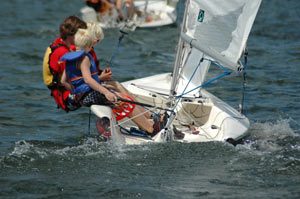
Fusion 15 sailing dinghy
When Fusion approached me late in 1999 to create a new dinghy design it was the opportunity I had been waiting for and I had a file folder full of sketches to prove it. Happily we were looking for the same thing – a boat that filled the gap between the current flock of high performance athletic tip-over-at-the-dock dinghies and the daysailers we grew up with. The Fusion 15 is the culmination of that vision.
Fast, fun and easy to sail was the philosophy. We realized those weren’t new ideas, but I think because we stayed true to the plan during development, we successfully achieved the goals and produced a boat that is quite different from the rest of the pack.
The young crowd have locked onto the boat far more than I would have expected – perhaps because it has the looks and excitement of a go-fast machine. The older crowd, like me, appreciates the stability that avoids the extremes of skittish tippy and ho-hum stable. It is fast to rig and the sailplan makes it easy to sail. Everyone likes the fact that if you do happen to capsize you are off and sailing again with no water in the boat in seconds, not minutes.
Safety after a capsize is one area of focus in the Fusion. The sculpted open transom lets water, whether from the rain, spray or a capsize, flush cleanly out the back. The interior molding in the boat has a floor which slopes aft but remains high enough above the waterline that water always flows out, not in.
Stability was another focus. It is easy to adjust the stability of the boat on the drawing board. Although the shape of the waterline and the center of gravity of the entire boat are important, the most significant influence is the beam of the boat at the waterline. The wider it is, the more stable the boat. But the wider the boat, the slower it will be in lighter air conditions when that additional wetted surface will add more drag. As with most decisions in yacht design, the final choice is a compromise. We wanted comfortable stability at the dock and yet inspiring performance under sail.
In the effort to match the boat’s goals (fun, fast and friendly), there was great debate as to whether the boat should have a spinnaker. The third sail adds fun but is generally cumbersome to hoist and gybe. The asymmetrical spinnakers that are now on many sport boats are easier to handle, but the bowsprit makes maneuvering by novice crews more difficult and the large spinnaker area permitted by the sprit was not needed. So we gave the boat a modest clipper bow that extends the tack position of the asymmetrical spinnaker about 8″ forward of the jib tack. This gives the wind adequate breathing space to fill the sail and makes launching the spinnaker from the foredeck chute as simple as pulling on the halyard. The self-tacking jib expands the horizons for the Fusion sailor – it means the boat can be single-handed (because the jib can take care of itself), sailed with an inexperienced crew, or raced with 2 crew with the focus shifted back to tactics and strategy rather than athletics. The small Harken traveler zings across the track as the boat is tacked.
The rather unique jib lead terminates on a swivel jam-cleat on the mast just below the boomvang. The crew can easily hold the sheet in their hand as they tack and either ease and re-tighten the sail (if they are looking for the best performance) or not do anything (if they want to relax). After hoisting the asymmetrical spinnaker or when heading for the dock at the end of the day, the roller furling jib is spun out of the way by pulling the line mounted on the back of the foredeck.
Because of the shape of the interior molding, the centerboard box protrudes only about six inches above floor level. This provides a nice foot rest and is the logical spot for the hiking straps.
Initial speed trials with the prototype indicate the boat is right on track. It is indeed fast and fun and has made a hit with sailors.
Length : 15ft 8
Beam : 5ft 6
Weight : 290lbs
Sail Area : 142 sq. ft. (Main Jib)
Portsmouth Yardstick : 91.1 (US)
